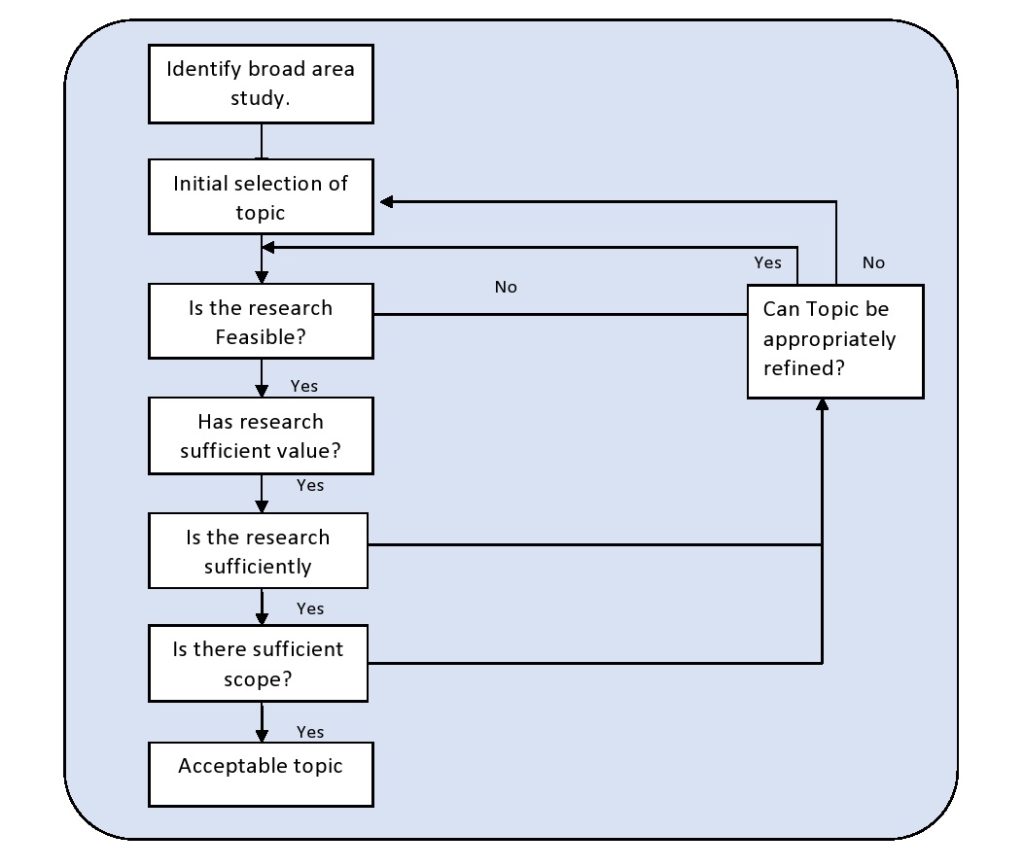Share this article
The prospects of selecting a good topic would be considerably enhanced if a systematic approach were followed. The first step is an identification of the broad area of study. K. Howard and I. A. Sharp (1983) suggested a systematic process of topic selection.

Figure 1. The Process of Topic Selection (Howard & Sharp).
Sources of potential topics
Figure 1 above suggests that a systematic pattern be followed in topic selection. The student would be helped in this if he directs his mind to identifying potential sources of good topic. These includes,
- Contemporary events: Newspaper and the media generally describe societal problems, which require attention and solution. A research student who exposes himself generously to the media would become aware of those problems from which researchable topics could be fashioned.
- Past research projects: Completed projects at different levels often indicate areas in which further research could be carried out.
- Academic journal and authorities: Authorities in different fields often publish articles and comments in academic journals and give lectures to the public at different Fora. From all these, a perspective research problem may form which good topic could be derived.
- Practitioners and users of Research: In the field of marketing for example, a respected and known marketing manager may point out gaps in knowledge, which hamper his decision-making. This may provide a basis for research.
- Generally accepted but unproved assertions: In every field of endeavor, there are ideas, which are “common knowledge” and accepted as basis for action but which have not been subjected to proof e.g. many managers assume that budgets improve performance. This may of course be true, but it is also subject to validation.
- Discussion with colleagues: An often-overlooked source of good topic is the conversations a student may often hold with his colleagues. These conversations, because of the relaxed and informal setting, which surround them, do have the potential to generate researchable ideas.
Techniques for generating research topics
Students may often need definite method as to how to generate topics for themselves. Three major techniques have been considered important and useful to the researcher in the generation of topics. These are: the use of analogy, relevance trees and morphological analysis.
- The Use of Analogy: Analogy as used here refers to the ability to develop a topic in a particular subject area drawing from a development in another subject area.
- Relevance Trees: These represent a good model of how people generally think about problems. A relevance tree suggests a way of developing related ideas from a starting concept in a decompositional
- Morphological Analysis:This is another technique, which can be applied for topic generation. It flows a threefold process as follows:
- Objective 2. Methodology 3. Area of research
Thus, we can say that morphological analysis consists of identifying the important dimensions of a subject and examine their interrelationship.
How to formulate a research proposal?
Students often experience considerable difficulties in the formulating of a proposal. However difficult as the development of a proposal may appear it is thought an essential preliminary of any research. A research proposal tries to satisfy at least two important requirements.
- It enables the researcher focus his thoughts on the major objectives of the project, the means of achieving these objectives and the possible outcome of the project.
- It results in the production of a document, which forms a basis for discussions with your supervisor and guidelines for the actual execution of the project.
The process of producing a research proposal is repetitive in the sense that various submissions are continuously refined until a final document is ready. Many institutions also insist on a proposal seminar whose purpose is a formal presentation of the proposal before an audience, which consists of other researcher in related disciplines. Whatever comments are available following this seminar lead to a further revision of the proposal.
Components of a Research Proposal
There are many versions of what a proposal should contain. However, the format that follows provides a basis for compiling an acceptable proposal.
- Introduction: Delineate the general area within which the research is to be undertaken and outline the manner in which the proposal is to be presented.
- Objective of the research: This constitutes the justification for wishing to undertake the research project while also listing serially all, it is not feasible or necessary to formulate a hypothesis, and the statement of the objectives would often constitute a major basis for judging the likely contribution of a project.
- A statement of research problem including if necessary a formulation of hypothesis: Many researchers recommend that formal problem statements be made at two levels:
- First, a general and probably “idealized” version and
- Second a most concrete, down to earth and operational statement, which describes briefly what the researcher plan to do.
- Importance of topic: It constitutes a statement of the researcher’s perception of why it is important that the research be undertaken. It tries to give an avowal as to the non-trival nature of the topic of the project.
- Brief review of related literature: In order to convince the audience that the research is worthwhile, and that you have the competence to carry it out, it is pertinent to demonstrate familiarity with the subject area through a literature review. This review should in addition help the audience to assure itself that the proposed research work will:
- Not duplicate or repeat work that has already been executed.
- Add to or complement existing knowledge
- Be consistent with the broad principles of the existing state of knowledge.The literature review should bear direct relevance to the project being undertaken.
- Research Methodology: This section should be as explicit as possible in detailing how the research would be carried out. The type of data to be collected should be specified, so also should the sources of data and methods to be used in collecting them be stated. It is important that you think through the reasons for selecting any particular method or technique because the analytical approach adopted is largely dependent on the type of data collected. If a questionnaire is to be used, the methodology of the questionnaire should be included. The population should be clearly defined, while the method of sample selection should be described in some details.
- Anticipated results and or contribution to knowledge if applicable: This section should briefly state that the likely findings of the research would be and the importance of these findings. We should note that although we often expect that our research hypothesis, if any, would be confirmed, we should however not fail to indicate what significance our findings will hold.
- Table of contents of proposed project including a description of each chapter: This section serves to further focus the mind the researcher on the logic in the presentation data. It should outline the different chapters that the final project will contain giving also a summary in broad headings or short sentence the major content of each chapter.
- Time table and budget: As a guide, a timetable, indicating when the critical section of the project is expected to be completed, is quite useful. A budget is similarly useful particularly when there is the hope of attracting outside fund:
- Bibliography: This should cite all the materials that have been consulted in the preparation of the proposal. It should again be emphasized that a proposal is a play, which the researcher is expected to follow. Most people may also consider the introductory method aspects as beer important in writing the proposal.
Credits:
Prof. Abraham O. A
















